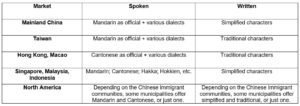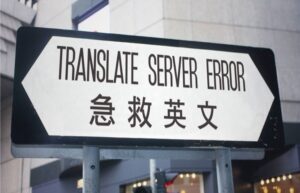Demystifying the Difference Between Simplified Chinese vs. Traditional Chinese

Simplified Chinese vs. Traditional Chinese, Mandarin vs. Cantonese⏤there are plenty of myths and misconceptions when it comes to the Chinese language. Many such misconceptions even persist in the language services industry, where seasoned language services providers (LSPs) make factual mistakes that they could avoid with a little more knowledge (and asking the right questions). One such misconception: Simplified characters are only used for Mandarin and Traditional characters are only used with Cantonese.
What’s the difference between these Chinese variants, and which one should you choose for your Chinese translations?
Traditional Chinese vs. Simplified Chinese throughout history
Before answering the question, “What should we use⏤Simplified or Traditional; Mandarin or Cantonese?”, we have to go back to some linguistic and historical lessons (without getting too technical).
The Chinese language evolved in such a unique way that there is a disconnect between how it is spoken and how it is written. What you see might not be what you pronounce. In addition, there are dozens of dialects spoken in China, many being mutually unintelligible, as is the case with Mandarin and Cantonese.
The Chinese logographic writing system (i.e., characters) used to be “multi-centered” during ancient times. That is, each state within what is now China during the “Warring States Period” developed its own variant of the writing system, hindering smooth communication across regions. In the Qin Dynasty⏤China’s first imperial dynasty, Qin Shi Huang, the First Emperor of Qin, instituted a range of reforms aiming at unifying his vast empire, including standardizing the writing system. This unified writing system, despite having gone through different eras of war and turmoil, has since been keeping the Chinese nation unified throughout millennia.
In terms of the Simplified vs. Traditional Chinese phenomenon we see today, it is another stage of the evolution of written Chinese and a long history of writing system reforms.
In 1919, when China was humiliated at the Paris Peace Conference, nationalists launched a massive New Culture Movement in an attempt to bring China’s traditional culture into the 20th century. One of the prominent features of the New Culture Movement was baihua, or written vernacular Chinese, an endeavor to break from traditional literary Chinese and bring literacy to the masses.
Some intellectuals, while critically reflecting on the nation’s backwardness, radically blamed the writing system and advocated for Romanization (as happened in some Asian languages, such as Vietnamese). This, of course, turned out to be futile. With illiteracy rates among the general public above 90% at the time, an alternative proposal was to simplify complex characters, which they thought would make learning to read and write much easier.
After the fall of the Qing Dynasty in 1911, the Nationalist government organized a group of scholars to simplify Chinese writing. However, their work was interrupted by war and political turmoil. Simplification work resumed in Mainland China from 1956 to 1964, when the first General List of Simplified Characters was published. With later minor additions, and a failed second list in the 1970s, the 1964 list has been the basis for standardized Chinese writing in Mainland China through today. In all, there is a total of 2,238 simplified characters on the 1964 list; the rest remain unchanged.
Other Chinese regions⏤Taiwan, Hong Kong, and Macau, as well as the Chinese diaspora⏤didn’t pursue further simplification and continued to use what is now known as Traditional Chinese as their standard writing system.
Differences between spoken and written Chinese
When we talk about Traditional or Simplified Chinese, we are only talking about the writing system. In terms of spoken language, various Chinese dialects are still very much alive and spoken, with Mandarin being promoted as the lingua franca and official language of the People’s Republic of China. While Romanization did not catch on as a writing system, pinyin (developed in Mainland China) is a modern-day Romanized tool to help transcribe Chinese words and teach Mandarin pronunciation, which is why you probably recognize words like ni hao and xie xie (hello and thank you, respectively).
Mandarin has been used as the official language in both Mainland China and Taiwan. However, for writing, Simplified Chinese is used on the Mainland, while Traditional Chinese is used in Taiwan.
Cantonese, one of dozens of Chinese dialects, is the official language in Hong Kong and Macao. The writing system in Hong Kong and Macao is Traditional Chinese. However, in Guangdong (formerly Canton) Province, where this dialect originated, they use simplified characters as Guangdong is part of Mainland China.
Chinese across the globe
Things are trickier for overseas Chinese communities: in Malaysia, Singapore, and Indonesia, the Chinese writing used to be traditional characters. But as China gained influence in the world, the regions’ Chinese communities switched to Simplified Chinese.
For overseas Chinese communities in other parts of the world, including North America, Australia, and Europe, traditional characters used to be dominant. However, with more immigrants coming from Mainland China, the written language has evolved into a mixture of traditional and simplified.
Which version of “Chinese” should you translate into?
For non-Chinese speakers, this complex linguistic landscape can be confusing. If you are wondering which versions of spoken and/or written Chinese you need to translate into, it all comes back to this question: “Who are you trying to communicate with?”
The table below is a summary to help you map your target markets:

If you have content to be translated into Chinese, this chart can help you clarify which script to use. Many professional Chinese translators are proficient in both scripts. However, you still need to practice discretion, as there are regional differences even within the same script or dialectical setting. For example, the traditional characters in Taiwan can be different from those in Hong Kong, as different dialects are spoken. Mandarin on the Mainland is different from the Mandarin in Taiwan, due to differences in terminology and wording preferences.
Ideally, you should always choose a native of the target script for any language service needs. If you are unsure, consult a professional, such as an ATA-certified translator.
By Fang Sheng
About the Author
 Fang Sheng is an ATA-certified English into Chinese and Chinese into English translator. Mr. Sheng is based in Toronto, Canada. In addition to being a professional translator and conference interpreter, Mr. Sheng is also a personal history researcher and an avid writer.
Fang Sheng is an ATA-certified English into Chinese and Chinese into English translator. Mr. Sheng is based in Toronto, Canada. In addition to being a professional translator and conference interpreter, Mr. Sheng is also a personal history researcher and an avid writer.
1 Comments
Leave a Comment Cancel Reply
Language Services Directory
Subscribe to The ATA Compass
Connect with The ATA Compass
Recent Posts
What is a Certified Translation?
What are the basics of a certified translation? In the United States, anyone can certify a translation. A translator does not need to be certified in order to provide a…
Read MoreMachine Translation
What is machine translation? Machine translation (MT) is the use of automated software that translates text without human involvement. Adaptive MT is a technology that learns and adjusts in real-time…
Read MoreKnow Your Rights to Language Access
Is English Not Your Primary Language? If you have a limited ability to read, write, speak, or understand English, you are considered to be Limited English Proficient (LEP). As an…
Read MoreTranslator vs. Interpreter
Watch a Day in the Life of Translators and Interpreters See how translators and interpreters work in this short animated video. Translators do the writing Translators work with the written…
Read MoreExploring Translation and Interpreting Services
Why Are Language Services Essential in an Internationalized World? In a world where communication knows no bounds, effective language services are paramount. ATA helps you find professional translators and interpreters…
Read MoreWhy Should I Hire a Professional?
It takes more than just the ability to understand two languages. Professional translators and interpreters have the education, experience, and expertise to understand the nuances in one language and transfer…
Read More







A very clear explanation for LSPs and users of translation/interpretation. Well done!